Effectiveness of Air Filtration in Reducing PM2.5 Exposures at a School in a Community Heavily Impacted by Air Pollution
Abstract
:1. Introduction
2. Materials and Methods
2.1. Study Setting and Design
2.2. Air Filtration Strategies
2.2.1. Portable Air Cleaners (PACs)
2.2.2. Improved HVAC Filters
2.3. Data Collection
2.4. Data Analysis
3. Results
3.1. Fine Particulate Matter (PM2.5)
3.2. Portable Air Cleaner (PAC) Use
3.3. Carbon Dioxide (CO2)
4. Discussion
4.1. PM2.5 and Filtration Effectiveness
4.2. Portable Air Cleaner Use
4.3. Ventilation and Particle Filtration Effectiveness
4.4. Limitations
5. Conclusions
Supplementary Materials
Author Contributions
Funding
Institutional Review Board Statement
Informed Consent Statement
Data Availability Statement
Acknowledgments
Conflicts of Interest
Appendix A
Appendix B
| HVAC Filter Intervention | Location | PAC (Yes/No) | Filtration Effectiveness 1 (%) Median | Change in Filtration Effectiveness 1 after HVAC Filter Intervention (%) | |
|---|---|---|---|---|---|
| Pre-HVAC Filter Intervention 2 | Post-HVAC Filter Intervention 3 | ||||
| Upgrade: MERV 6 → MERV 13 | Classroom 1 | No | 19.26 | 30.33 | 11.07 (p < 0.001) 4 |
| Classroom 2 | No | −5.36 | 16.74 | 22.10 (p < 0.001) 4 | |
| Classroom 3 | Yes: Speed 3 (220 m3/h) | 14.38 | 14.49 | 0.11 (p = 0.12) | |
| Replacement: MERV 13 → MERV 13 | Classroom 4 | Yes: Speed 5 (340 m3/h) | 45.50 | 38.98 | −6.52 (p = 0.08) |
| Classroom 5 | Yes: Speed 3 (220 m3/h) | 55.87 | 43.03 | −12.84 (p < 0.001) 4 | |
| HVAC Filter Intervention | Location | Portable Air Cleaner | Median I/O Ratio | |
|---|---|---|---|---|
| Pre-HVAC Filter Intervention | Post-HVAC Filter Intervention | |||
| Upgrade: MERV 6 → MERV 13 | Classroom 1 | No | 0.81 | 0.70 * |
| Classroom 2 | No | 1.05 | 0.83 * | |
| Classroom 3 | Yes: Speed 3 | 0.86 | 0.86 | |
| Replacement: MERV 13 → MERV 13 | Classroom 4 | Yes: Speed 5 | 0.54 | 0.61 |
| Classroom 5 | Yes: Speed 3 | 0.44 | 0.57 * | |
Appendix C

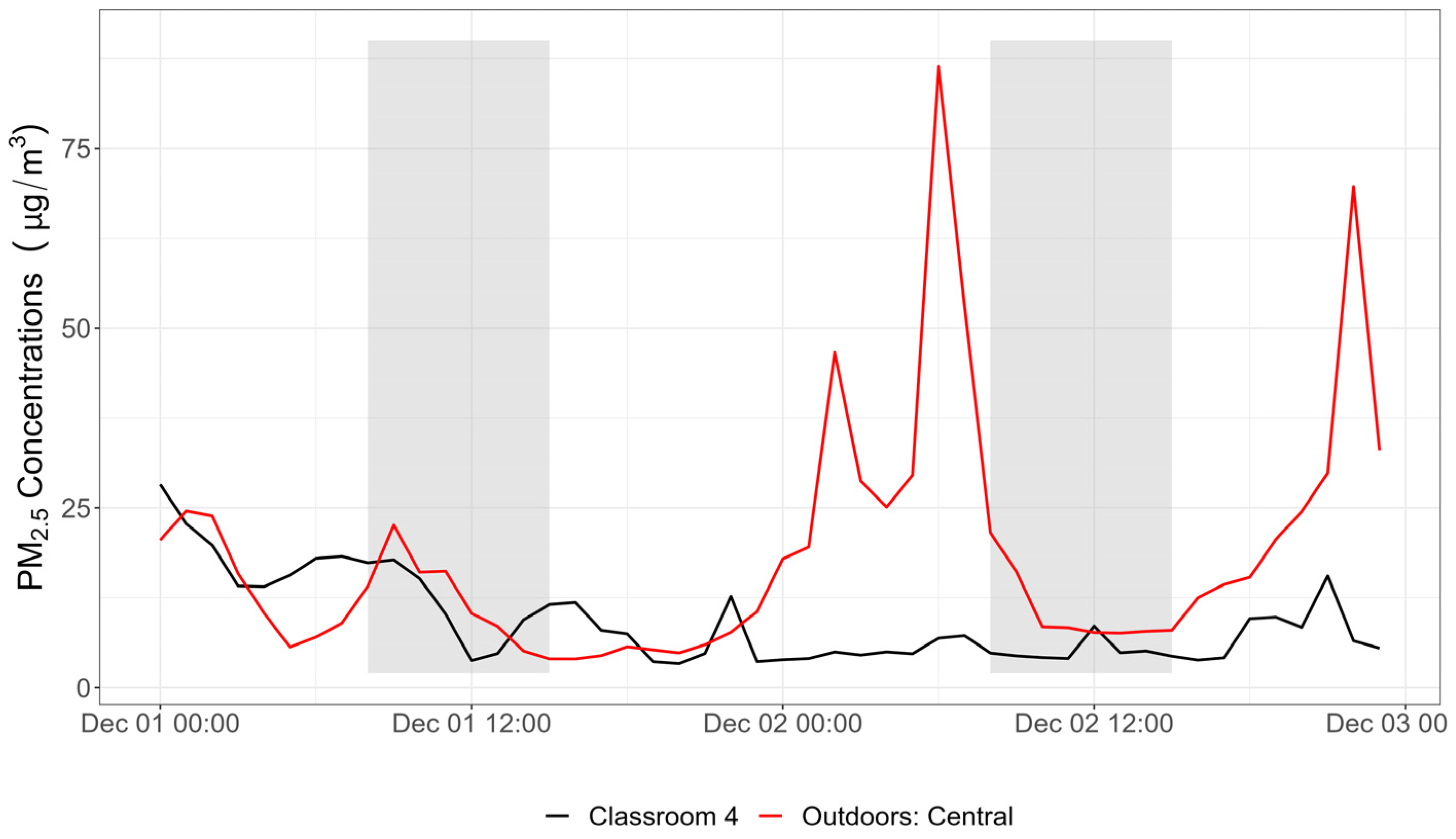
References
- Feng, S.; Gao, D.; Liao, F.; Zhou, F.; Wang, X. The health effects of ambient PM2.5 and potential mechanisms. Ecotoxicol. Environ. Saf. 2016, 128, 67–74. [Google Scholar] [CrossRef]
- Sharma, S.; Chandra, M.; Kota, S.H. Health Effects Associated with PM2.5: A Systematic Review. Curr. Pollut. Rep. 2020, 6, 345–367. [Google Scholar] [CrossRef]
- Buka, I.; Koranteng, S.; Osornio-Vargas, A.R. The effects of air pollution on the health of children. Paediatr. Child Health 2006, 11, 513–516. [Google Scholar] [PubMed]
- World Health Organization; Regional Office for Europe & European Centre for Environment and Health. Effects of Air Pollution on Children’s Health and Development: A Review of the Evidence; WHO Regional Office for Europe: Copenhagen, Denmark, 2005. [Google Scholar]
- Polidori, A.; Fine, P.M.; White, V.; Kwon, P.S. Pilot study of high-performance air filtration for classroom applications. Indoor Air 2013, 23, 185–195. [Google Scholar] [CrossRef]
- US EPA. Why Indoor Air Quality is Important to Schools. Available online: https://www.epa.gov/iaq-schools/why-indoor-air-quality-important-schools (accessed on 1 April 2023).
- San Joaquin Valley Air Pollution Control District. Community Emissions Reduction Program Stockton. Available online: https://community.valleyair.org/media/5hrl3haf/final-stockton-cerp-no-appendix-with-cover.pdf (accessed on 4 December 2022).
- OEHHA. CalEnviroScreen 4.0. Available online: https://oehha.ca.gov/calenviroscreen/report/calenviroscreen-40 (accessed on 15 December 2023).
- California Air Resources Board. Community Air Protection Program Stockton. Available online: https://ww2.arb.ca.gov/our-work/programs/community-air-protection-program/communityhub-2-0/stockton (accessed on 4 December 2022).
- California Air Resources Board. Community Air Protection Program. Available online: https://ww2.arb.ca.gov/capp/about (accessed on 27 April 2023).
- Bennett, D.H.; Moran, R.E.; Krakowiak, P.; Tancredi, D.J.; Kenyon, N.J.; Williams, J.; Fisk, W.J. Reductions in particulate matter concentrations resulting from air filtration: A randomized sham-controlled crossover study. Indoor Air 2022, 32, e12982. [Google Scholar] [CrossRef] [PubMed]
- Fisk, W.J. Health benefits of particle filtration. Indoor Air 2013, 23, 357–368. [Google Scholar] [CrossRef]
- Fisk, W.J.; Chan, W.R. Effectiveness and cost of reducing particle-related mortality with particle filtration. Indoor Air 2017, 27, 909–920. [Google Scholar] [CrossRef] [PubMed]
- Zhao, D.; Azimi, P.; Stephens, B. Evaluating the Long-Term Health and Economic Impacts of Central Residential Air Filtration for Reducing Premature Mortality Associated with Indoor Fine Particulate Matter (PM2.5) of Outdoor Origin. Int. J. Environ. Res. Public Health 2015, 12, 8448–8479. [Google Scholar] [CrossRef]
- van der Zee, S.C.; Strak, M.; Dijkema, M.B.; Brunekreef, B.; Janssen, N.A. The impact of particle filtration on indoor air quality in a classroom near a highway. Indoor Air 2017, 27, 291–302. [Google Scholar] [CrossRef]
- Tong, Z.; Li, Y.; Westerdahl, D.; Freeman, R.B. The impact of air filtration units on primary school students’ indoor exposure to particulate matter in China. Environ. Pollut. 2020, 266, 115107. [Google Scholar] [CrossRef]
- Park, J.-H.; Lee, T.J.; Park, M.J.; Oh, H.; Jo, Y.M. Effects of air cleaners and school characteristics on classroom concentrations of particulate matter in 34 elementary schools in Korea. Build. Environ. 2020, 167, 106437. [Google Scholar] [CrossRef] [PubMed]
- ASHRAE. ASHRAE Filtration/Disinfection. Available online: https://www.ashrae.org/technical-resources/filtration-disinfection (accessed on 15 December 2022).
- Walia, A. Preparing TK-12 Schools for California’s Changing Climate: Health and Energy Considerations for Preparing for Wildfire Smoke; Stanford Climate and Energy Policy Program; Stanford Woods Institute for the Environment: Stanford, CA, USA, 2023. [Google Scholar]
- US EPA. What Is a MERV Rating? Available online: https://www.epa.gov/indoor-air-quality-iaq/what-merv-rating (accessed on 4 December 2022).
- U.S. Department of Energy’s Office of Energy Efficiency and Renewable Energy. Efficient and Healthy Schools. Available online: https://www.energy.gov/eere/buildings/efficient-and-healthy-schools (accessed on 15 December 2023).
- Biomonitoring California. AB 617 Biomonitoring Update 032522. Available online: https://biomonitoring.ca.gov/sites/default/files/downloads/AB617UpdatePlanning032522.pdf (accessed on 21 April 2024).
- Biomonitoring California. AB 617 Biomonitoring Update 071621. Available online: https://biomonitoring.ca.gov/sites/default/files/downloads/AB617Update071621.pdf (accessed on 22 April 2024).
- Wagner, J.; Castorina, R.; Kumagai, K.; Thompson, M.; Sugrue, R.; Noth, E.M.; Bradman, A.; Hurley, S. Identification of Airborne Particle Types and Sources at a California School Using Electron Microscopy. Atmosphere 2023, 14, 1702. [Google Scholar] [CrossRef]
- IQAir. IQAir HealthPro Series User Manual. Available online: https://www.iqair.com/sites/default/files/pdf/HP-NE_User-Manual-US_120827.pdf (accessed on 29 June 2024).
- Jenkins, P.L.; Phillips, T.J.; Waldman, J. Environmental Health Conditions in California’s Portable Classrooms; California Environmental Protection Agency, Air Resources Board: Sacramento, CA, USA, 2004. Available online: https://ww2.arb.ca.gov/resources/documents/california-portable-classrooms-study (accessed on 1 March 2024).
- FilterBuy. Different Air Filter Ratings: FPR vs. MERV vs. MPR. Available online: https://filterbuy.com/resources/air-filter-basics/merv-mpr-fpr-ratings/ (accessed on 20 September 2022).
- Torkan Fazli, B.S. In-Situ Residential HVAC Filtration Efficiency for Fine and Ultrafine Particles. Available online: https://built-envi.com/wp-content/uploads/Fazli-and-Stephens-Air-Media-Fall-2016-In-situ-Filter-Testing.pdf (accessed on 25 April 2024).
- Ardon-Dryer, K.; Dryer, Y.; Williams, J.N.; Moghimi, N. Measurements of PM2.5 with PurpleAir under atmospheric conditions. Atmos. Meas. Tech. 2020, 13, 5441–5458. [Google Scholar] [CrossRef]
- PurpleAir. PurpleAir PA-II. Available online: https://www2.purpleair.com/products/purpleair-pa-ii?variant=40067691708513 (accessed on 20 November 2023).
- Monitor Testing and Calibration. Available online: https://www.sjvair.com/about/testing/ (accessed on 19 October 2022).
- Onset. HOBO CO2 Logger (MX1102) User’s Manual. Available online: https://www.onsetcomp.com/resources/documentation/19198-mx1102-manual (accessed on 27 April 2023).
- Onset. HOBO Plug Load Data Logger (UX120-018) User’s Manual. Available online: https://www.onsetcomp.com/resources/documentation/17838-man-ux120-018 (accessed on 27 April 2023).
- R Core Team. R: A Language and Environment for Statistical Computing, v4.3.1; R Foundation for Statistical Computing: Vienna, Austria, 2021.
- David, C.; Carslaw, K.R. openair—An R package for air quality data analysis. Environ. Model. Softw. 2012, 27–28, 52–61. [Google Scholar] [CrossRef]
- McCarthy, M.C.; Ludwig, J.F.; Brown, S.G.; Vaughn, D.L.; Roberts, P.T. Filtration effectiveness of HVAC systems at near-roadway schools. Indoor Air 2013, 23, 196–207. [Google Scholar] [CrossRef] [PubMed]
- Batterman, S. Review and Extension of CO2-Based Methods to Determine Ventilation Rates with Application to School Classrooms. Int. J. Environ. Res. Public Health 2017, 14, 145. [Google Scholar] [CrossRef] [PubMed]
- Kabirikopaei, A.; Lau, J. Uncertainty analysis of various CO2-Based tracer-gas methods for estimating seasonal ventilation rates in classrooms with different mechanical systems. Build. Environ. 2020, 179, 107003. [Google Scholar] [CrossRef]
- Andamon, M.M.; Rajagopalan, P.; Woo, J. Evaluation of ventilation in Australian school classrooms using long-term indoor CO2 concentration measurements. Build. Environ. 2023, 237, 110313. [Google Scholar] [CrossRef]
- Ding, E.; Zhang, D.; Hamida, A.; García-Sánchez, C.; Jonker, L.; de Boer, A.R.; Bruijning, P.C.J.L.; Linde, K.J.; Wouters, I.M.; Bluyssen, P.M. Ventilation and thermal conditions in secondary schools in the Netherlands: Effects of COVID-19 pandemic control and prevention measures. Build. Environ. 2023, 229, 109922. [Google Scholar] [CrossRef]
- Mendell, M.J.; Eliseeva, E.A.; Davies, M.M.; Spears, M.; Lobscheid, A.; Fisk, W.J.; Apte, M.G. Association of classroom ventilation with reduced illness absence: A prospective study in California elementary schools. Indoor Air 2013, 23, 515–528. [Google Scholar] [CrossRef]
- Chan, W.R.; Li, X.; Singer, B.C.; Pistochini, T.; Vernon, D.; Outcault, S.; Sanguinetti, A.; Modera, M. Ventilation rates in California classrooms: Why many recent HVAC retrofits are not delivering sufficient ventilation. Build. Environ. 2020, 167, 106426. [Google Scholar] [CrossRef]
- de Foy, B.; Schauer, J.J. Changes in speciated PM2.5 concentrations in Fresno, California, due to NOx reductions and variations in diurnal emission profiles by day of week. Elem. Sci. Anthr. 2019, 7, 45. [Google Scholar] [CrossRef]
- San Joaquin Valley Air Pollution Control District. Chapter 3. Air Quality in the San Joaquin Valley: Challenges and Trends. Available online: https://ww2.valleyair.org/media/xrkdi03x/03-chapter-3-aq-in-sjv.pdf (accessed on 23 April 2024).
- San Joaquin Valley Air Pollution Control District. San Joaquin Valley Air Pollution Control District: Frequently Asked Questions. Available online: https://ww2.valleyair.org/about/frequently-asked-questions/ (accessed on 15 May 2024).
- US EPA. Final Rule: Reconsideration of the National Ambient Air Quality Standards for Particulate Matter. Available online: https://www.federalregister.gov/documents/2024/03/06/2024-02637/reconsideration-of-the-national-ambient-air-quality-standards-for-particulate-matter (accessed on 17 May 2024).
- World Health Organization. WHO Global Air Quality Guidelines. Particulate matter (PM2.5 and PM10), Ozone, Nitrogen Dioxide, Sulfur Dioxide and Carbon Monoxide. Available online: https://iris.who.int/bitstream/handle/10665/345329/9789240034228-eng.pdf (accessed on 13 May 2024).
- Chen, W.; Wang, Z.-M.; Peerless, K.; Ullman, E.; Mendell, M.J.; Putney, D.; Wagner, J.; Kumagai, K. Monitoring of Ventilation, Portable Air Cleaner Operation, and Particulate Matter in California Classrooms: A Pilot Study. Sustainability 2024, 16, 2052. [Google Scholar] [CrossRef]
- Persily, A. Development and application of an indoor carbon dioxide metric. Indoor Air 2022, 32, e13059. [Google Scholar] [CrossRef] [PubMed]
- California Green Building Code 2022, Section 5.506.3 Carbon Dioxide (CO2) Monitoring in Classrooms. Available online: https://up.codes/s/carbon-dioxide-co2-monitoring-in-classrooms (accessed on 4 March 2024).
- Shendell, D.G.; Winer, A.M.; Weker, R.; Colome, S.D. Evidence of inadequate ventilation in portable classrooms: Results of a pilot study in Los Angeles County. Indoor Air 2004, 14, 154–158. [Google Scholar] [CrossRef] [PubMed]
- Fromme, H.; Twardella, D.; Dietrich, S.; Heitmann, D.; Schierl, R.; Liebl, B.; Rüden, H. Particulate matter in the indoor air of classrooms—Exploratory results from Munich and surrounding area. Atmos. Environ. 2007, 41, 854–866. [Google Scholar] [CrossRef]
- Lazovic, I.; Jovašević-Stojanović, M.; Zivkovic, M.; Tasic, V.; Žarko, S. PM and CO2 variability and relationship in different school environments. Chem. Ind. Chem. Eng. Q. 2014, 21, 179–187. [Google Scholar] [CrossRef]
- Choe, Y.; Shin, J.-S.; Park, J.; Kim, E.; Oh, N.; Min, K.; Kim, D.; Sung, K.; Cho, M.; Yang, W. Inadequacy of air purifier for indoor air quality improvement in classrooms without external ventilation. Build. Environ. 2022, 207, 108450. [Google Scholar] [CrossRef]
- Shi, L.; Zanobetti, A.; Kloog, I.; Coull, B.A.; Koutrakis, P.; Melly, S.J.; Schwartz, J.D. Low-Concentration PM2.5 and Mortality: Estimating Acute and Chronic Effects in a Population-Based Study. Environ. Health Perspect. 2016, 124, 46–52. [Google Scholar] [CrossRef]
- Papadogeorgou, G.; Kioumourtzoglou, M.A.; Braun, D.; Zanobetti, A. Low Levels of Air Pollution and Health: Effect Estimates, Methodological Challenges, and Future Directions. Curr. Environ. Health Rep. 2019, 6, 105–115. [Google Scholar] [CrossRef]
- South Coast Air Quality Management District. PurpleAir PA-II—Field Evaluation. Available online: https://www.aqmd.gov/docs/default-source/aq-spec/field-evaluations/purple-air-pa-ii---field-evaluation.pdf?sfvrsn=11 (accessed on 4 March 2024).
- Frederick, S.; Johnson, K.; Johnson, C.; Yaga, R.; Clements, A. Performance Evaluations of PM2.5 sensors in Research Triangle Park, NC: PurpleAir PA-II-SD, Aeroqual AQY, Applied Particle Technology Maxima, Vaisala AQT420, Sens-it RAMP, and Clarity Node-S. Available online: https://cfpub.epa.gov/si/si_public_record_report.cfm?Lab=CEMM&dirEntryId=348487 (accessed on 22 July 2024).
- Tyner, T.; Central California Asthma Collaborative, Fresno, CA, USA. Personal communication, 2022.

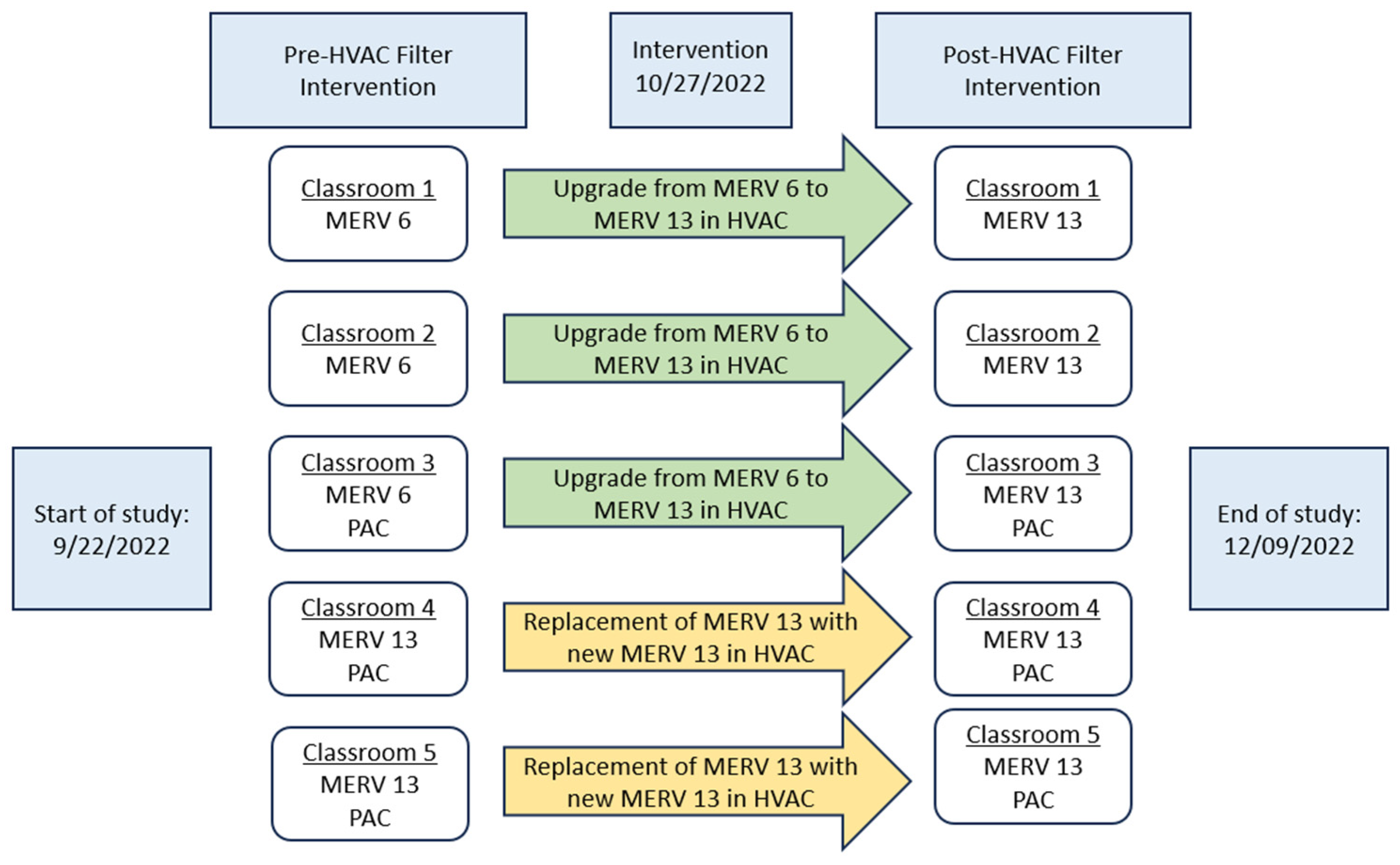
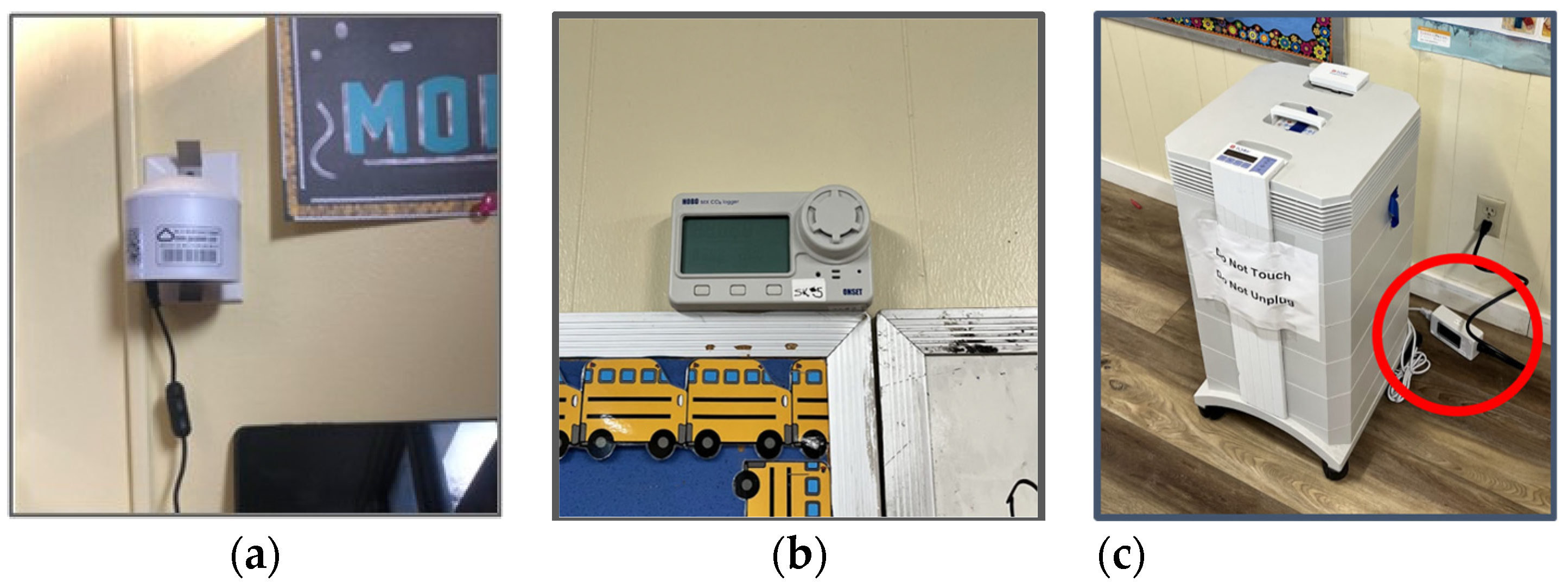

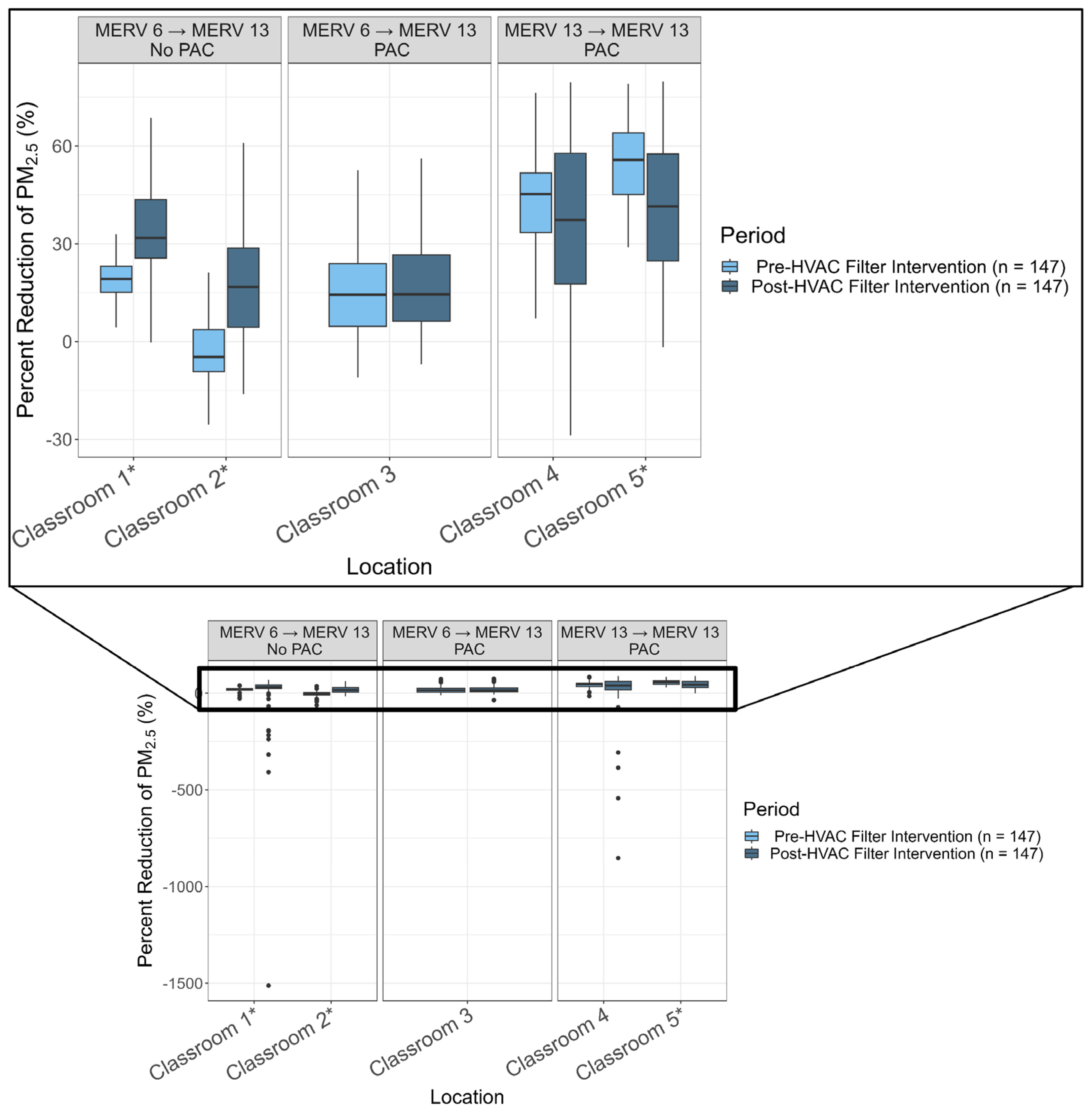


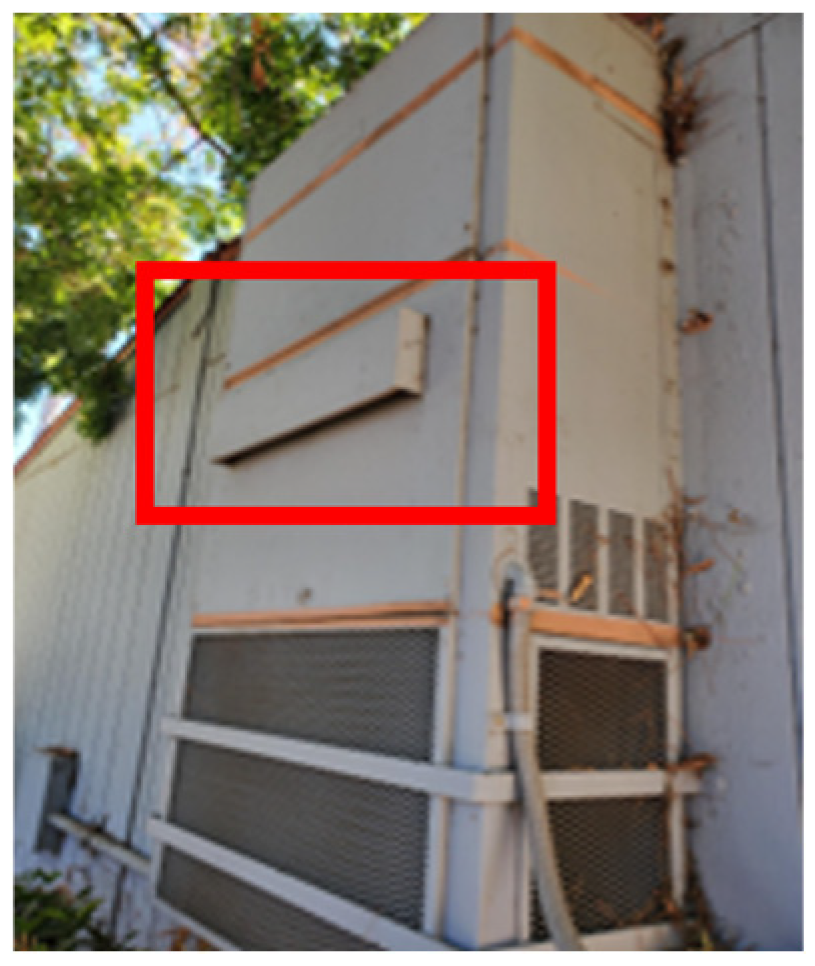
| Classroom Number | Occupancy 1 | Volume (m3) | Classroom Type 2 | Classroom Function | Portable Air Cleaner 3 | HVAC Filter: Pre-Intervention 4 | HVAC Filter: Post-Intervention |
|---|---|---|---|---|---|---|---|
| Classroom 1 | 17 | 245 | Permanent | General Ed. | No | MERV 6 | MERV 13 |
| Classroom 2 | 10 | 240 | Permanent | General Ed. | No | MERV 6 | MERV 13 |
| Classroom 3 | 15 | 240 | Permanent | General Ed. | Yes | MERV 6 | MERV 13 |
| Classroom 4 | 10 | 195 | Portable | English | Yes | MERV 13 | MERV 13 |
| Classroom 5 | 20 | 195 | Portable | Science | Yes | MERV 13 | MERV 13 |
| PAC Speed Setting | Flow Rate (m3/h) | Power Consumption (Watts) | ||
|---|---|---|---|---|
| Classroom 3 | Classroom 4 | Classroom 5 | ||
| Level 1 | 70 | 27 | 27 | 27 |
| Level 2 | 130 | 52 | 52 | 51 |
| Level 3 | 220 | 85 | 88 | 87 |
| Level 4 | 290 | 113 | 114 | 115 |
| Level 5 | 340 | 168 | 163 | 167 |
| Level 6 | 510 | 224 | 220 | 225 |
| Parameter | Instrument | Manufacturer | Data Frequency | Locations Monitored |
|---|---|---|---|---|
| PM2.5 | PA-II | PurpleAir | 2 min | Classrooms 1–5, Outdoors: North and Central |
| CO2 | HOBO MX 1102 data logger | Onset | 5 min | Classrooms 1–5 |
| PAC Power Usage | HOBO UX 120-018 plug load data logger | Onset | 1 min | Classrooms 3–5 |
| HVAC Filter Intervention | Location | PAC (Yes/No) | PM2.5 (µg/m3) Mean +/− SD | |
|---|---|---|---|---|
| Pre-HVAC Filter Intervention 1 | Post-HVAC Filter Intervention 2 | |||
| Outdoors: North | Not applicable | 10.1 +/− 3.1 | 12.1 +/− 7.3 | |
| Outdoors: Central | Not applicable | 9.7 +/− 3.5 | 10.9 +/− 7.9 | |
| Upgrade: MERV 6 → MERV 13 | Classroom 1 | No | 8.2 +/− 2.4 | 10.1 +/− 10.8 |
| Classroom 2 | No | 9.9 +/− 2.9 | 8.0 +/− 5.2 | |
| Classroom 3 | Yes: Speed 3 (220 m3/h) | 7.7 +/− 2.0 | 8.1 +/− 5.6 | |
| Replacement: MERV 13 → MERV 13 | Classroom 4 | Yes: Speed 5 (340 m3/h) | 5.2 +/− 1.6 | 6.2 +/− 6.0 |
| Classroom 5 | Yes: Speed 3 (220 m3/h) | 4.1 +/− 1.4 | 5.1 +/− 3.2 | |
Disclaimer/Publisher’s Note: The statements, opinions and data contained in all publications are solely those of the individual author(s) and contributor(s) and not of MDPI and/or the editor(s). MDPI and/or the editor(s) disclaim responsibility for any injury to people or property resulting from any ideas, methods, instructions or products referred to in the content. |
© 2024 by the authors. Licensee MDPI, Basel, Switzerland. This article is an open access article distributed under the terms and conditions of the Creative Commons Attribution (CC BY) license (https://creativecommons.org/licenses/by/4.0/).
Share and Cite
Thompson, M.; Castorina, R.; Chen, W.; Moore, D.; Peerless, K.; Hurley, S. Effectiveness of Air Filtration in Reducing PM2.5 Exposures at a School in a Community Heavily Impacted by Air Pollution. Atmosphere 2024, 15, 901. https://doi.org/10.3390/atmos15080901
Thompson M, Castorina R, Chen W, Moore D, Peerless K, Hurley S. Effectiveness of Air Filtration in Reducing PM2.5 Exposures at a School in a Community Heavily Impacted by Air Pollution. Atmosphere. 2024; 15(8):901. https://doi.org/10.3390/atmos15080901
Chicago/Turabian StyleThompson, McKenna, Rosemary Castorina, Wenhao Chen, David Moore, Kyle Peerless, and Susan Hurley. 2024. "Effectiveness of Air Filtration in Reducing PM2.5 Exposures at a School in a Community Heavily Impacted by Air Pollution" Atmosphere 15, no. 8: 901. https://doi.org/10.3390/atmos15080901





